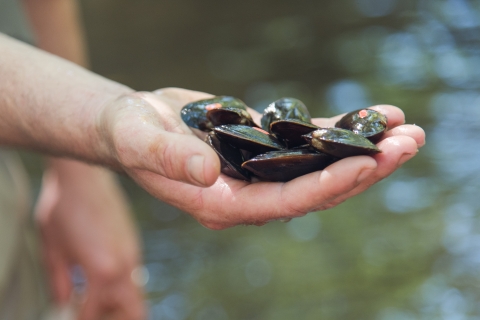Less than 300. In 2019, that’s how many Carolina heelsplitters were found dispersed within 11 populations left in the Catawba, Pee Dee, Saluda, and Savannah River Basins of North and South Carolina. A low number for a freshwater mussel that’s been listed as endangered since 1993. However, a team of biologists from the U.S. Fish and Wildlife Service's Southeast Region are leading efforts to restore habitat and propagate and release captive-reared heelsplitters. Their efforts are succeeding so well that there are now over 3,000 heelsplitters in the wild, mostly in South Carolina.
For their extraordinary initiative and accomplishment in bringing the Carolina heelsplitter back from the brink of extinction, five U.S. Fish and Wildlife Service biologists have been awarded the 2021 Southeast Recovery Champions Award. Receiving the award are Tony Brady, Morgan Wolf, Jonathan Wardell, Somerley Swarm, and Walter (Tripp) Boltin.
Members of the Carolina heelsplitter Intra-Service Recovery Initiative. Left to right: Tony Brady, Morgan Wolf, Jonathan Wardell, Somerley Swarm, and Walter "Tripp" Boltin.
The Carolina heelsplitter ranks at the top of all rarities in the Southeast. Lost from the record books since the 1800’s, the species was rediscovered in 1987. But by that time, most populations had been eliminated from North Carolina and a few were still hanging on in South Carolina – in geographic areas known as slate-belt stream systems. The U.S. Fish and Wildlife Service listed the species as endangered in 1993 and designated critical habitat for it in 2002.
Now, 10 of the 11 remaining Carolina heelsplitter populations are in South Carolina. Tony Brady, Morgan Wolf, and Jonathan Wardell established the Orangeburg Mussel Conservation Center (OMCC) at the Orangeburg National Fish Hatchery in South Carolina by transforming an empty shed into a functioning propagation system. Mussel biologists Brady, Wardell, and Swarm were primarily responsible for propagating and growing the mussels and maintaining the system. Wolf is the national lead for the Carolina heelsplitter, overseeing all recovery actions for the species.
Juvenile Carolina heelsplitter being grown out at the Orangeburg Mussel Conservation Center (OMCC) at the Orangeburg National Fish Hatchery in South Carolina
The establishment of the OMCC was a turning point for the species. Beginning in 2016, and over the next five years, more than 5,000 mussels were produced with close to 2,000 of those being released into the wild. In 2021 alone, more than 1,000 individuals, which is five times the number of heelsplitters ever released in a year, were stocked in South Carolina streams. The Service has been working closely with a number of partners throughout South Carolina, including the South Carolina Department of Natural Resources, to make that happen.
Carolina heelsplitter freshwater mussels ready for release in the wild
Restoring and reconnecting habitat for the Carolina heelsplitter has been a priority. Boltin led efforts to secure passageways for the heelsplitter and its primary fish host, the bluehead chub. He obtained funding and coordinated all endeavors to replace old culverts. Gills Creek in Lancaster County is home to about one third of the remaining habitat in the current range for the Carolina heelsplitter. Now, over five miles of critical habitat for the species has been restored, thanks to Boltin, other Service employees, and Lancaster County officials.
Old, dysfunctional culverts on Gills Creek in Lancaster County, South Carolina - critical habitat for the endangered Carolina heelsplitter freshwater mussel
Over the past five years, the Service’s Southeast Region Aquatic Habitat Restoration Team and other Service employees from throughout the region, have worked in partnership with Lancaster County officials and engineers, completing three separate culvert replacements on Gills Creek. Heavy equipment operators removed old, dysfunctional, round culverts and replaced them with bottomless arch culverts to restore adequate stream flow in the creek.
Tripp Boltin watching as flow is restored to Gills Creek, Lancaster County, South Carolina - critical habitat for the endangered Carolina heelsplitter
Musseling the Carolina heelspitter back from the brink of extinction has taken years of planning and, true to the “One Service” approach, the work of many Service employees, Lancaster County, and others. The work is still ongoing. Tony Brady, Morgan Wolf, Jonathan Wardell, Somerley Swarm, and Tripp Boltin are recovery champions for leading the successful process.






